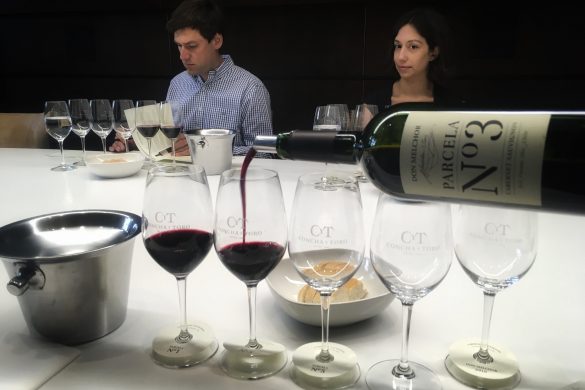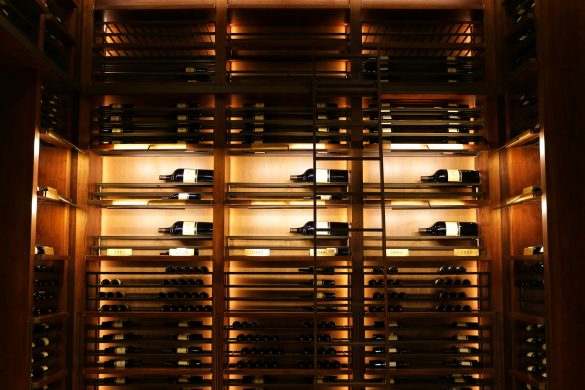Don Melchor wine has iconic status in Chile. It was first made in 1987 and is principally Cabernet Sauvignon (with a smidgen of Cabernet Franc, Merlot and Petit Verdot) from a vineyard on river gravel in Puente Alto. It is in this same sub-region where two other Chilean iconic Cabernet Sauvignon blends come from – Almaviva and Viñedo Chadwick – and some would consider these the holy trinity of Chilean Cabernet. Since Don Melchor’s release in the early 90s, it has been lauded as one of Chile’s top red wines and this was always the goal.
Don Melchor wine: A nod to history and a vision of the future
 The story of Don Melchor starts in 1883, when a Chilean politician and businessman – Don Melchor Concha y Toro – founded the Concha y Toro winery in Maipo. Concha y Toro has since gone on to become the largest wine producer in South America (and one of the largest in the world) with several wineries across Chile, one in Argentina, and countless brands and labels. The creation of the Don Melchor wine in 1987 – over 100 years later – was to celebrate the original founder and make a red wine that would be considered among the best of Chile.
The story of Don Melchor starts in 1883, when a Chilean politician and businessman – Don Melchor Concha y Toro – founded the Concha y Toro winery in Maipo. Concha y Toro has since gone on to become the largest wine producer in South America (and one of the largest in the world) with several wineries across Chile, one in Argentina, and countless brands and labels. The creation of the Don Melchor wine in 1987 – over 100 years later – was to celebrate the original founder and make a red wine that would be considered among the best of Chile.
The site where the grapes are grown is the Don Melchor vineyard, 127 hectares of vineyards divided into smaller lots and all planted on soils with a mixture of river gravel, sand and clay. The soils are well-draining and heat retentive, which is ideal for maturing and growing Cabernet Sauvignon. The mountain climate, at 650 metres above sea level, offers hot and sunny days with cool and dry nights. Alto Maipo is the mecca of Chilean Cabernet Sauvignon with good reason.
The fruit all comes from their ‘Don Melchor clone’ of Cabernet Sauvignon – taken from a massal selection of pre-phylloxera material that has been growing in Chile for over a century. The lots are kept separately and routinely tasted and whittled down by the local winemaking team to isolate the best barrels and lots. Head Winemaker Enrique Tirado then takes samples to Bordeaux, where he and consultant winemaker Jacques Boissenot diagnose what the final blend will be. After a year and a half in barrel, the wine is bottled and kept for another year before release.
Experiencing Don Melchor with a visit to the mansion
The art of blending and ruminating over the differences between the lots of Cabernet Sauvignon in the vineyard can be experienced first-hand with a visit to the Casona of Don Melchor. The original family mansion, built in the 1880s, is set in a handsome 22-hectare estate with towering trees, lush lawns and a picturesque lake. On my arrival, I was met by the resident expert on the mansion, Juan Carlos Lisoni, who took me on a toured around the gardens and house, sharing anecdotes about the family and talking about the Don Melchor legacy.
The house is kept immaculately, still with many of the original furnishings from the 19th century. Chandeliers, elaborately decorated chairs and polished wooden floors are picture perfect. As I walked around with a glass of Subercaseaux sparkling wine in hand, I could easily imagine what it was like sitting around the table for tea – or wine I hope – some hundred years ago.
The experience of Don Melchor, however, doesn’t stay in the 19th century. Behind two tall closed doors is a state-of-the-art tasting chamber with wall-to-wall cinema screens, a large oval-shaped tasting table and detailed maps of the Don Melchor vineyard lots. It feels like a Batman’s cave for wine.
Following an immersive video experience, I was poured three samples of the 2018 vintage from different lots in the Don Melchor vineyard by Massimo Leonori, the resident sommelier at the mansion. Although each was distinctively Cabernet Sauvignon and they shared a similar style and profile, there were marked differences between them too. Lot 1 was softer, sweeter and with plush red fruit notes; Lot 3 was spicier, more savoury and with peppery tannins; and Lot 5 was filled with fresh dark forest fruit and had a lively floral finish. Don Melchor winemaker Isabel Mitarakis then blended the three lots together to show how the act of blending creates a more complex and polished Cabernet Sauvignon.
Then the final glass was served – the current vintage of Don Melchor. Already expertly blended and aged for over a year in barrel and over a year in bottle, the 2016 showed how all the parts come together to make one greater whole. The 2016 was a more challenging vintage in Chile. However, the different character of each vintage is what makes these wines interesting to taste. And this prompted us to visit another secret chamber in the mansion – the wine library.
Here every single vintage of Don Melchor, from 1987, was available to purchase – the only place in the world to have all 32 vintages in stock. It’s the sort of sight that makes a wine collector weak at the knees. Which is how you know that Don Melchor has become one of Chile’s most iconic wines.
Interview with Isabel Mitarakis on Don Melchor










